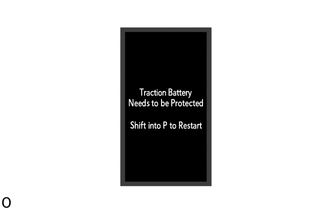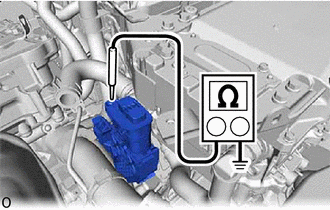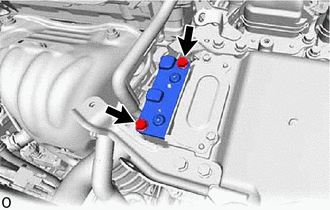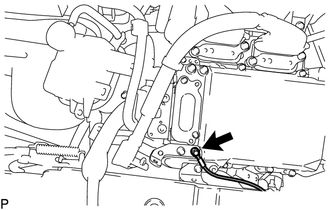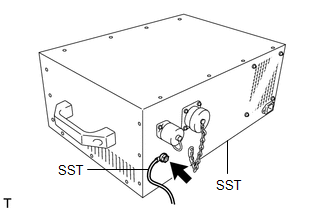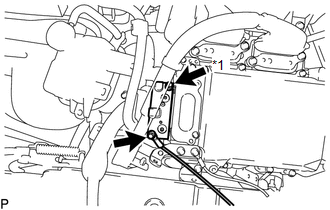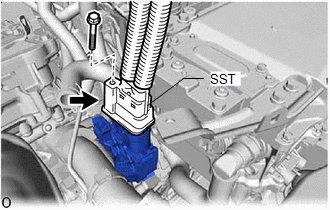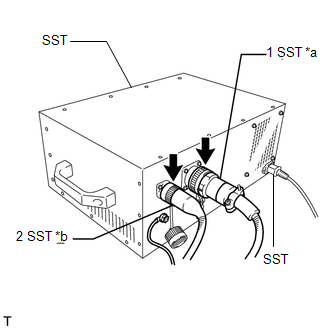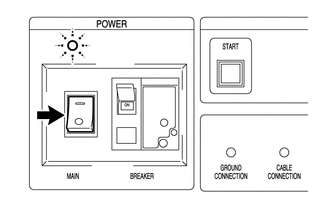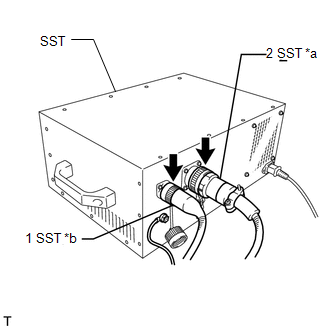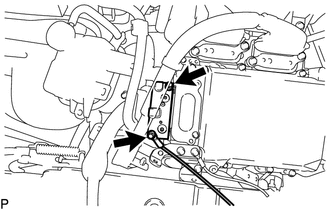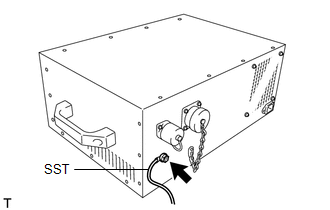Lexus NX: Charging
CHARGING
PROCEDURE
1. PRECAUTION
CAUTION:
Be sure to read Precaution thoroughly before servicing.
Click here .gif)
2. INSPECT AUXILIARY BATTERY VOLTAGE
Click here .gif)
3. PREPARATION FOR HV BATTERY CHARGING
CAUTION:
- Wear insulated gloves and use insulated tools.
- After removing the service plug grip, put it in your pocket to prevent other technicians from accidentally reconnecting it while you are working on the high-voltage system.
- After removing the service plug grip, wait for at least 10 minutes before touching any of the high voltage connectors or terminals.
NOTICE:
After removing the service plug grip, turning the power switch on (READY) may cause a malfunction. Do not turn the power switch on (READY) unless instructed by the repair manual.
HINT:
Waiting for at least 10 minutes is required to discharge the high-voltage capacitor inside the inverter with converter assembly.
(a) Check the charge level of the HV battery assembly.
| (1) Check whether the HV battery warning message is shown on the multi-information display. |
|
(2) Confirm if the engine starts. If the engine starts, leave it idling with the shift lever in P until the engine stops (self-charge has completed).
If the engine cannot start, follow the procedure to charge the HV battery assembly.
HINT:
- Before performing external charging, always use the Techstream to perform troubleshooting.
- Charging time using the THS charger is 10 minutes per charge cycle. The charging time when using a THS charger is a short charging time (when the HV battery temperature is 25°C (77°F), 10 minutes may be sufficient, if the HV battery temperature is 0°C (32°F), then three 10 minute charge cycles may be required) for putting the engine in a condition where it can be started (the system can enter the READY-on state). (The THS charger will automatically stop 10 minutes after charging starts.)
(b) Remove the service plug grip.
Click here .gif)
.gif)
(c) Disconnect the wire harness.
Click here .gif)
(d) Remove the inverter reserve tank assembly.
Click here .gif)
(e) Remove the connector cover assembly.
Click here .gif)
(f) Check terminal voltage.
Click here .gif)
(g) Disconnect the No. 2 frame wire.
Click here .gif)
| (h) Measure the resistance according to the value(s) in the table below. HINT: If the shield line of the No. 2 frame wire is not securely connected to body ground, the THS charger will not operate. The "FAULT" and "CABLE CONNECTION" warning lights will illuminate on the THS charger. Standard Resistance:
|
|
(i) If the result is not as specified, inspect the installation state of the No. 2 frame wire.
| (j) Temporarily install the connector cover assembly with the 2 bolts to prevent any foreign matter or water from entering the inverter with converter assembly. |
|
(k) Connect the THS charger in the order shown by the numbers in the illustration.
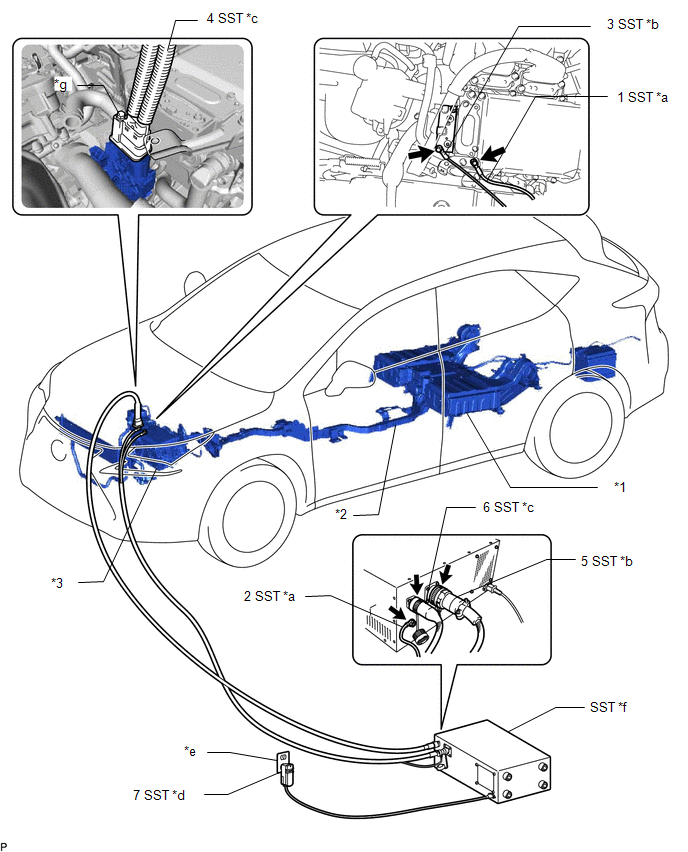
| *1 | HV Battery Assembly | *2 | No. 2 Frame Wire |
| *3 | Inverter with Converter Assembly | - | - |
| *a | EV Bonding Cable (Green Cable) | *b | Low Voltage Cable |
| *c | High Voltage Cable | *d | Power Input Plug |
| *e | Grounded AC 100 to 240 V Receptacle | *f | THS Charger |
| *g | Bolt (91553-80665) | - | - |
NOTICE:
- Make sure to connect the EV bonding cable first to prevent electrical shock.
- Connect all the THS charger cables in the order shown in the illustration to prevent electrical shock.
| (l) Connect SST (EV bonding cable (green cable)) to the installation bolt of the No. 2 inverter reserve tank bracket. SST: 09882-10070 Torque: 10 N·m {102 kgf·cm, 7 ft·lbf} |
|
| (m) Connect SST (EV bonding cable (green cable)) to SST (THS charger). SST: 09880-10021 09881-10041 |
|
| (n) Connect SST (low voltage cable) to the position shown in the illustration, and then tighten the bolt. Torque: 8.0 N·m {82 kgf·cm, 71 in·lbf} |
|
(o) Tighten the connector cover assembly bolt.
Torque:
8.0 N·m {82 kgf·cm, 71 in·lbf}
| (p) Connect the No. 2 frame wire to SST (high voltage cable) with the bolt (91553-80665). SST: 09882-10040 Torque: 8.0 N·m {82 kgf·cm, 71 in·lbf} NOTICE:
HINT: When connecting the high voltage cable, use a bolt with a nominal diameter of 6.0 mm (0.236 in.), a shaft length of 69.0 mm (2.72 in.) and a pitch of 1.0 mm (0.0394 in.). |
|
| (q) Connect SST (low voltage cable) and SST (high voltage cable) to SST (THS charger) in the order shown in the illustration. |
|
(r) Install the service plug grip.
Click here .gif)
.gif)
(s) Connect the negative (-) auxiliary battery terminal.
(t) Connect SST (power input plug) of SST (THS charger) to a grounded AC 100 to 240 V receptacle.
SST: 09881-10081
NOTICE:
Always use an AC 100 to 240 V receptacle with a properly functioning ground. The ground is designed to reduce the chance of electric shock if a malfunction occurs. Do not use the charger if any of the pins on its plug have been damaged or removed.
4. HV BATTERY CHARGING
(a) Connect the Techstream to the DLC3.
(b) Turn the power switch on (IG).
(c) Enter the following menus: Powertrain / Hybrid Control / Data List / Battery Charge.
Powertrain > Hybrid Control > Active Test| Tester Display |
|---|
| Battery Charge |
HINT:
- During the "Battery Charge" Active Test, check "System Main Relay Status - SMRB" and "System Main Relay Status - SMRG" in the Data List.
- If the Data List values are not as specified in the table below, turn the Techstream and the power switch off and then perform the HV battery charging procedure again.
"SMRB" and "SMRG" in Data List during "Battery Charge" Active Test:
| Step | Active Test Battery Charge | THS Charger START Switch | Data List System Main Relay Status - SMRB | Data List System Main Relay Status - SMRG |
|---|---|---|---|---|
| 1 | OFF | OFF | OFF | OFF |
| 2 | OFF → ON | OFF | OFF → ON | OFF → ON |
| 3 | ON | OFF → ON | ON | ON |
(d) Make sure that the EMERGENCY STOP switch is in the reset condition (the switch is turned clockwise and released).
(e) Make sure that the BREAKER is in the ON position.
| (f) Turn the THS charger MAIN switch on. HINT: The MAIN indicator will illuminate green. |
|
(g) Press the START switch.

HINT:
- When the START switch is turned on, the INITIAL CHECK indicator illuminates and an initial check starts. When the initial check completes successfully, the INITIAL CHECK indicator turns off, the CHARGING indicator illuminates and charging will start at the same time.
- While the INITIAL CHECK indicator is illuminated, the insulation, 400 V output, EMERGENCY STOP switch, connector connections and ground connection are inspected.
(h) Repeat the charge cycle 3 times. When the last cycle has finished, turn the THS charger MAIN switch off.
HINT:
- Charging time using the THS charger is 10 minutes per charge cycle. The charging time when using a THS charger is a short charging time (when the battery temperature is 25°C (77°F), 10 minutes may be sufficient, if the battery temperature is 0°C (32°F), then three 10 minute charge cycles may be required) for putting the engine in a condition where it can be started (the system can enter the READY-on state). (The THS charger will automatically stop 10 minutes after charging starts.)
- There is very little chance of overcharging the HV battery during the second or third charging cycle. The SOC will not likely increase beyond the upper limit because it was low enough to prevent the engine from starting. Even if the SOC was to increase enough to exceed the limit, the hybrid vehicle control ECU will stop the Active Test to prevent overcharging.
- Cranking the engine once causes the SOC to drop approximately 1%.
- Charging the HV battery once (10 minutes) using the THS charger restores the SOC approximately 2%.
(i) Turn the power switch off.
(j) Remove the THS charger and install the No. 2 frame wire.
NOTICE:
Make sure to disconnect the EV bonding cable last.
(1) Disconnect SST (power inlet plug) of the charger from the grounded AC 100 to 240 V receptacle.
(2) Disconnect the negative (-) auxiliary battery terminal.
(3) Remove the service plug grip.
Click here .gif)
.gif)
| (4) Disconnect SST (high voltage cable) and SST (low voltage cable) from SST (THS charger) in the order shown in the illustration. |
|
| (5) Remove the bolt (91553-80665) and disconnect SST (high voltage cable) from the No. 2 frame wire. NOTICE: Do not use the bolt (91553-80665) used for connecting the high voltage cable when reconnecting the No. 2 frame wire to the vehicle. |
|
| (6) Remove the bolt and disconnect SST (low voltage cable). |
|
| (7) Disconnect SST (EV bonding cable (green cable)) from the THS charger. |
|
| (8) Disconnect SST (EV bonding cable (green cable)) from the installation bolt of the No. 2 inverter reserve tank bracket. |
|
(9) Tighten the bolt.
Torque:
10 N·m {102 kgf·cm, 7 ft·lbf}
(10) Remove the connector cover assembly from the inverter with converter assembly.
(11) Connect the No. 2 frame wire.
Click here .gif)
(12) Install the connector cover assembly.
Click here .gif)
NOTICE:
Do not use the bolt (91553-80665) used for connecting the high voltage cable of the charger.
(13) Install the inverter reserve tank assembly.
Click here .gif)
(14) Connect the wire harness.
Click here .gif)
(15) Install the service plug grip.
Click here .gif)
.gif)
(k) Check if the engine starts.
HINT:
If the engine does not start, perform the HV battery charging operation again.
5. CHECK HV BATTERY AFTER HV BATTERY CHARGE
(a) Check for DTCs.
Click here .gif)
(b) Perform the self-charging operation.
(1) Start the engine and leave it idling with the shift lever in P until the engine stops.
HINT:
When the engine stops idling, this indicates that self-charging is complete. Perform any initialization procedures required after the negative terminal of the auxiliary battery is disconnected and reconnected.

